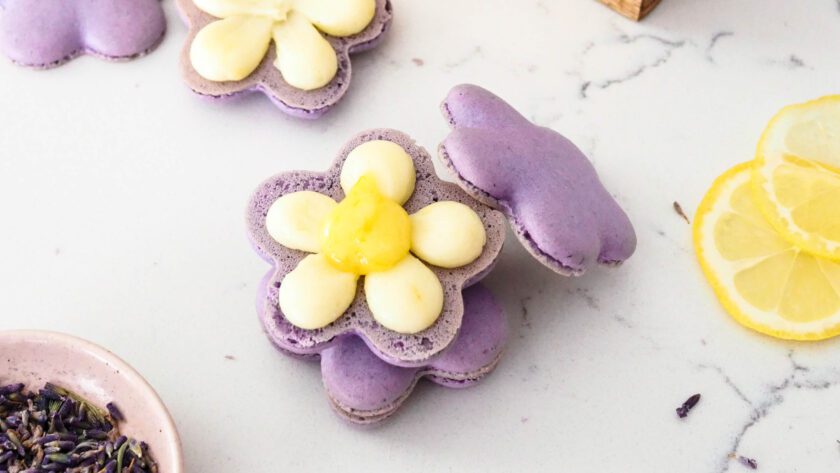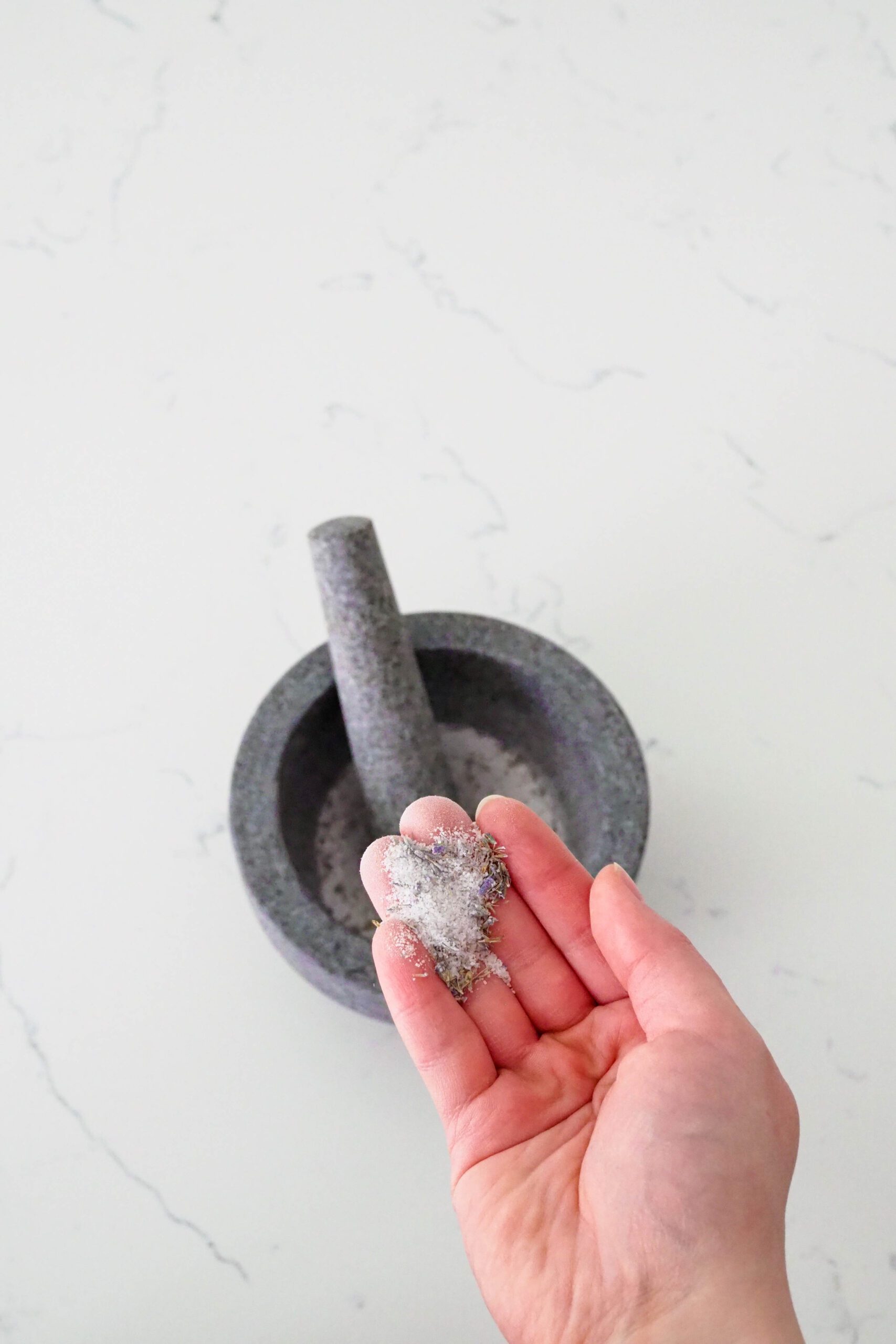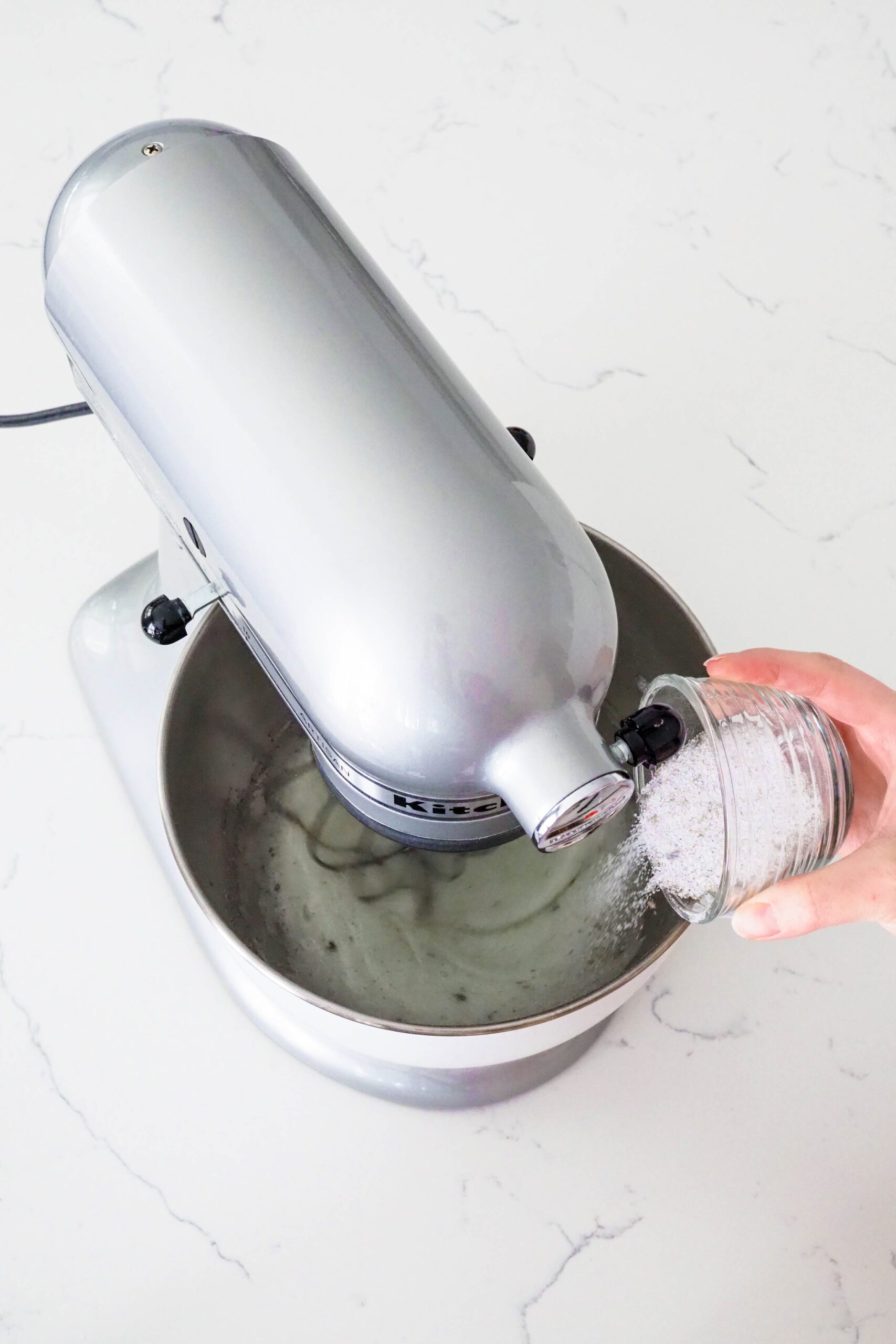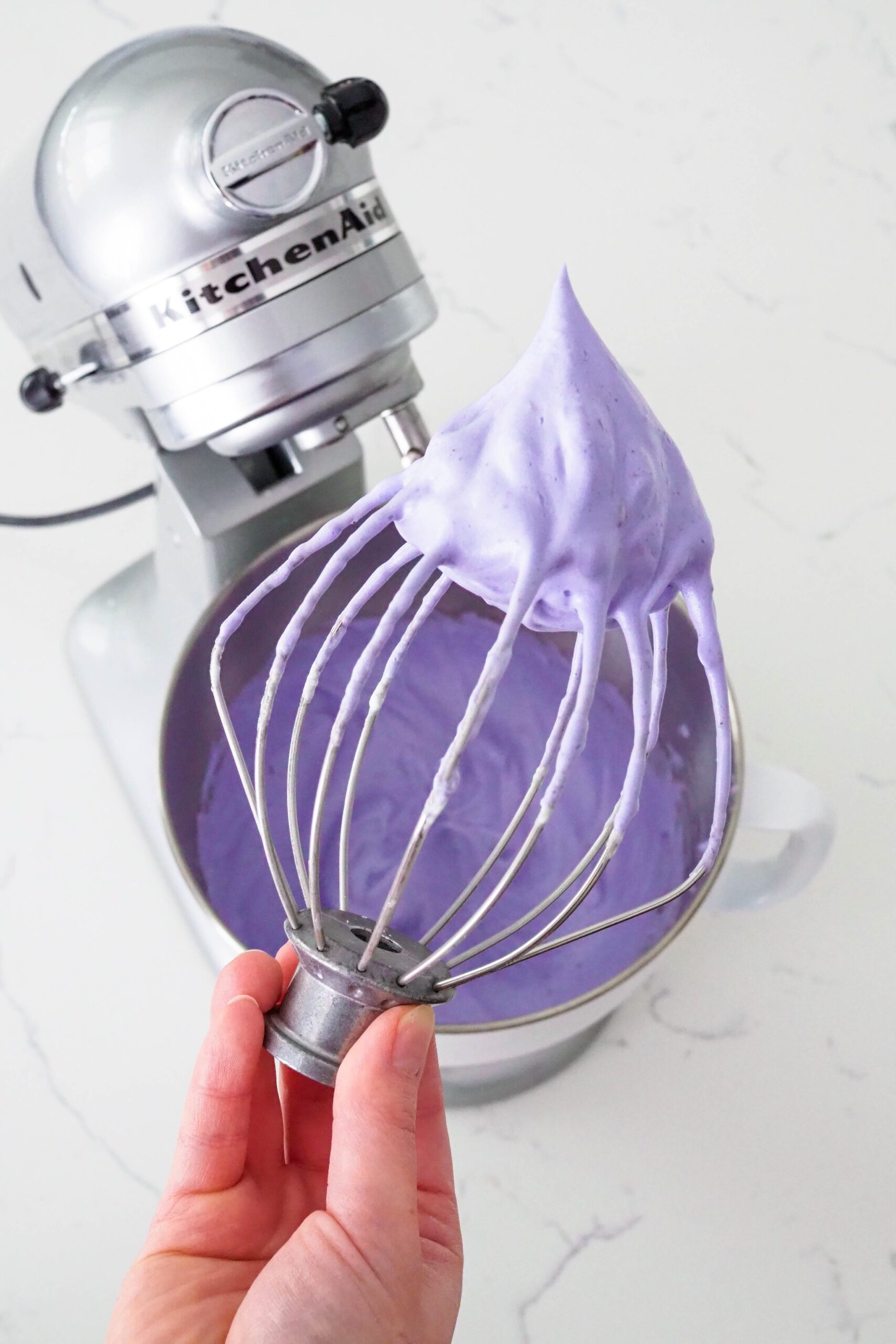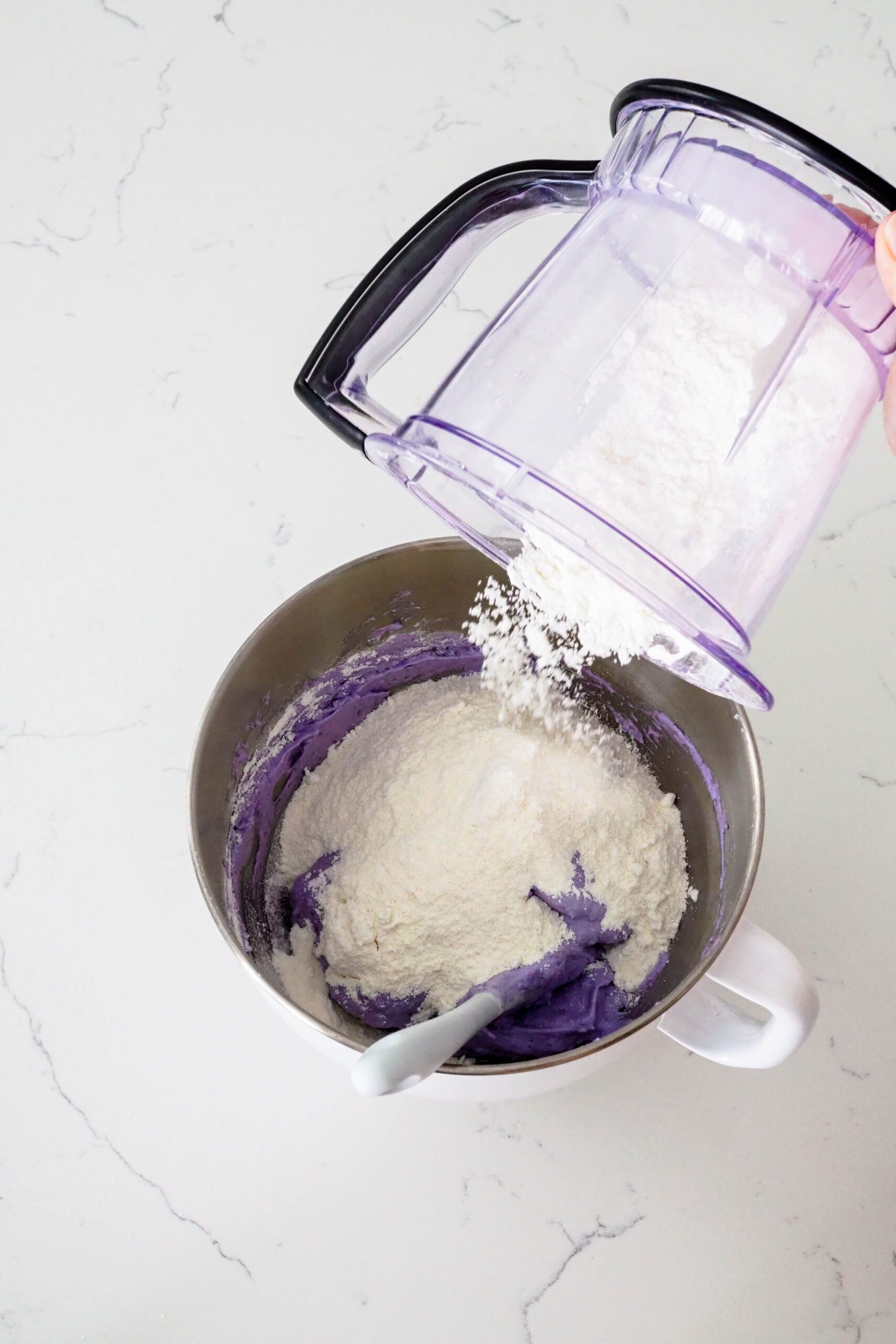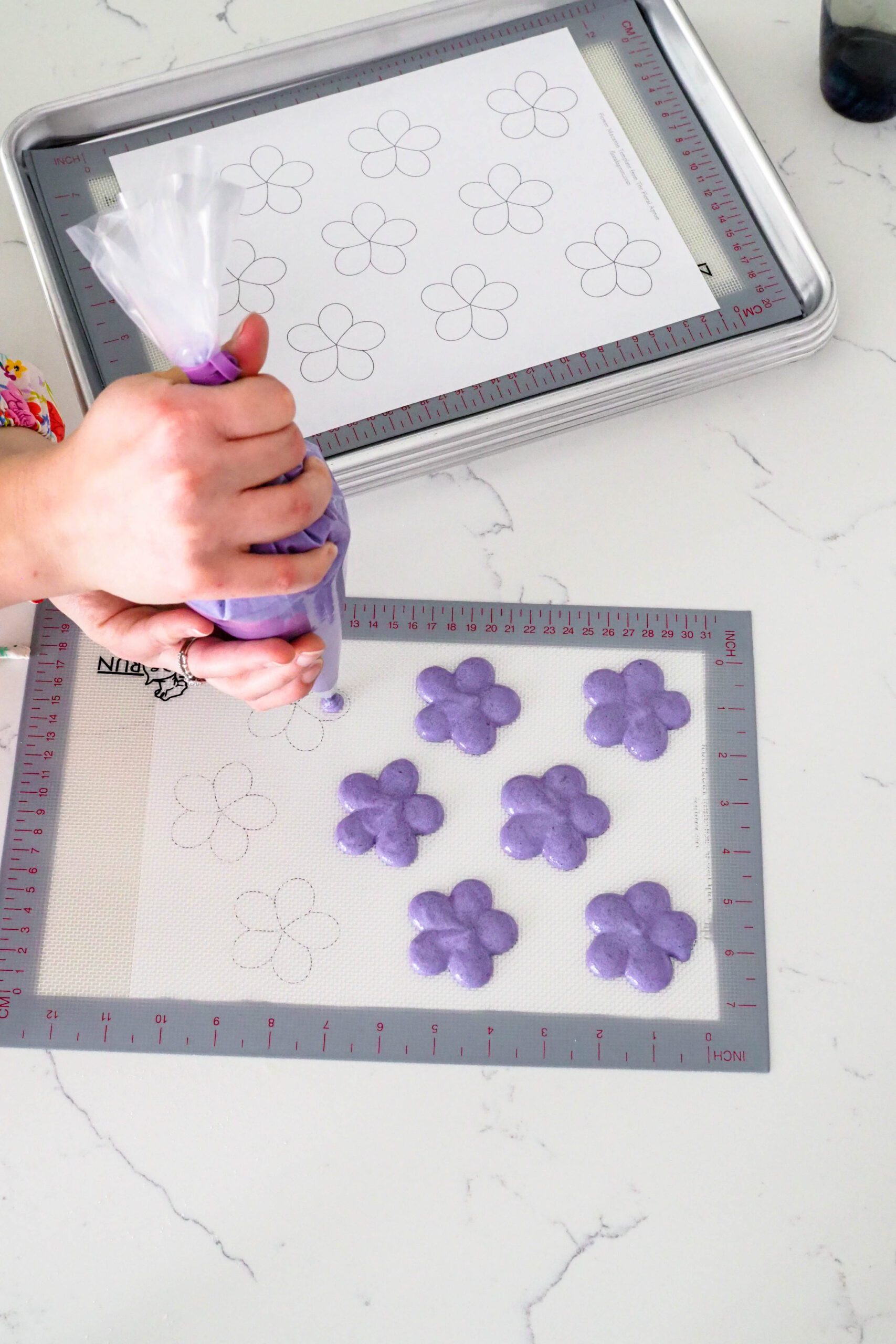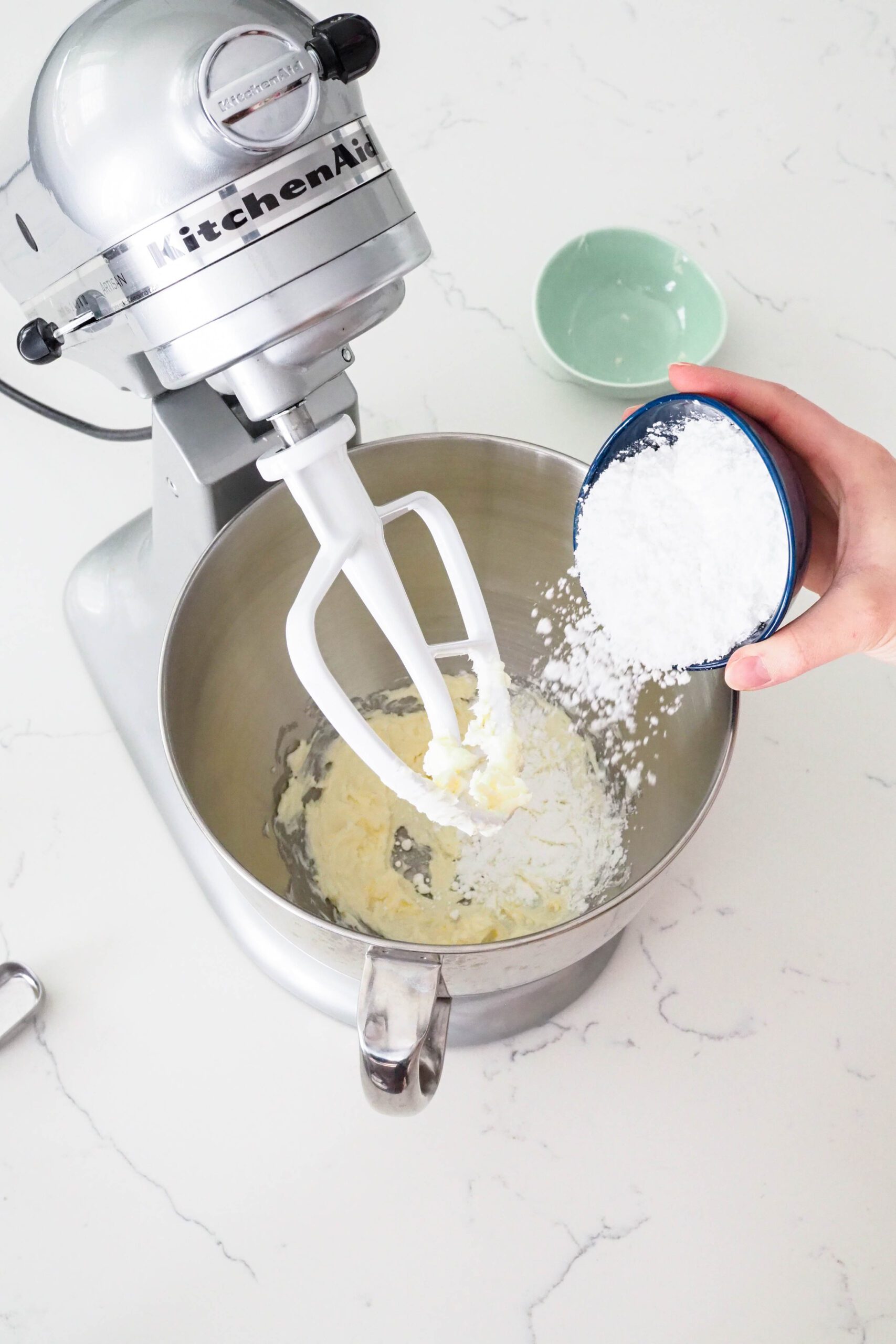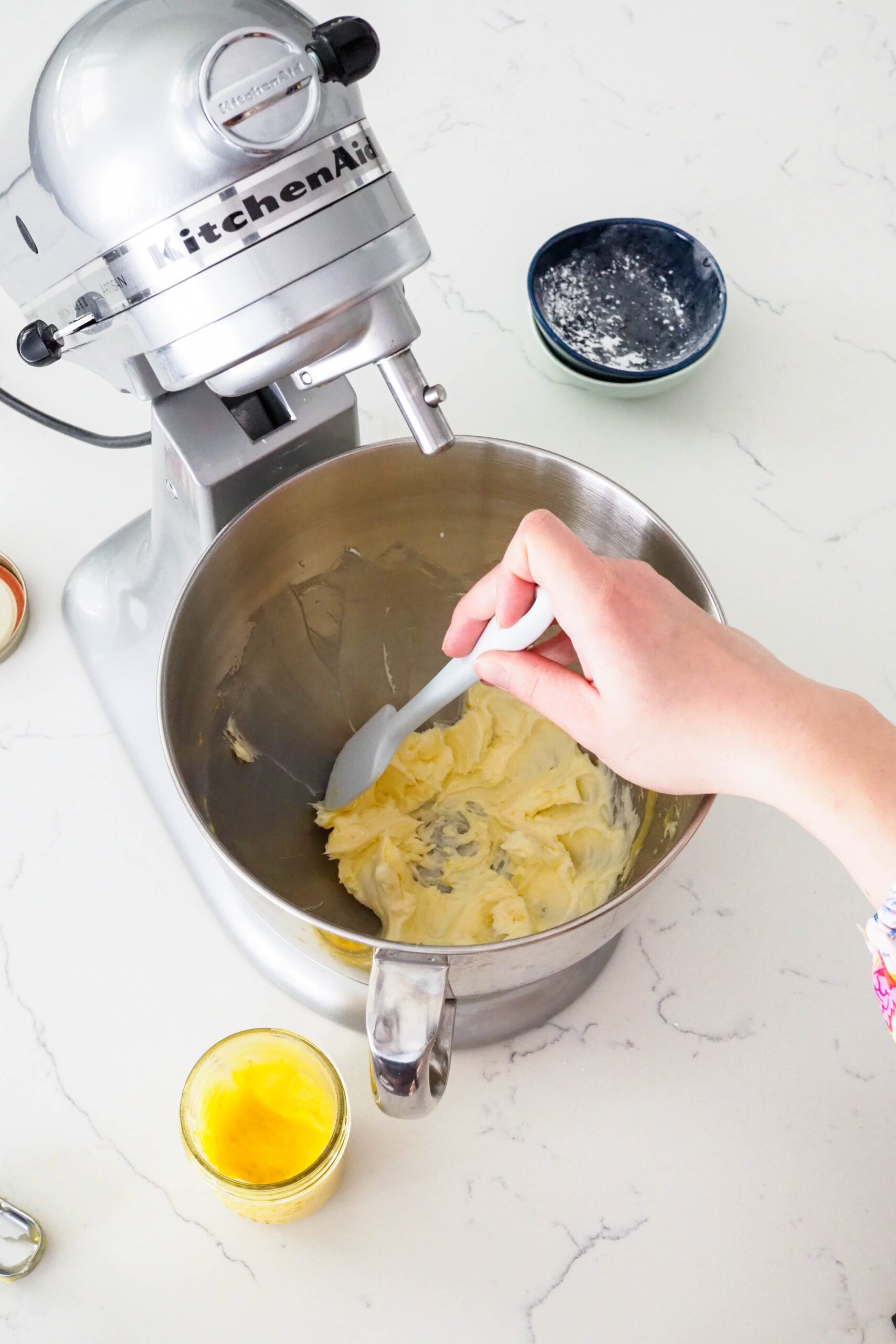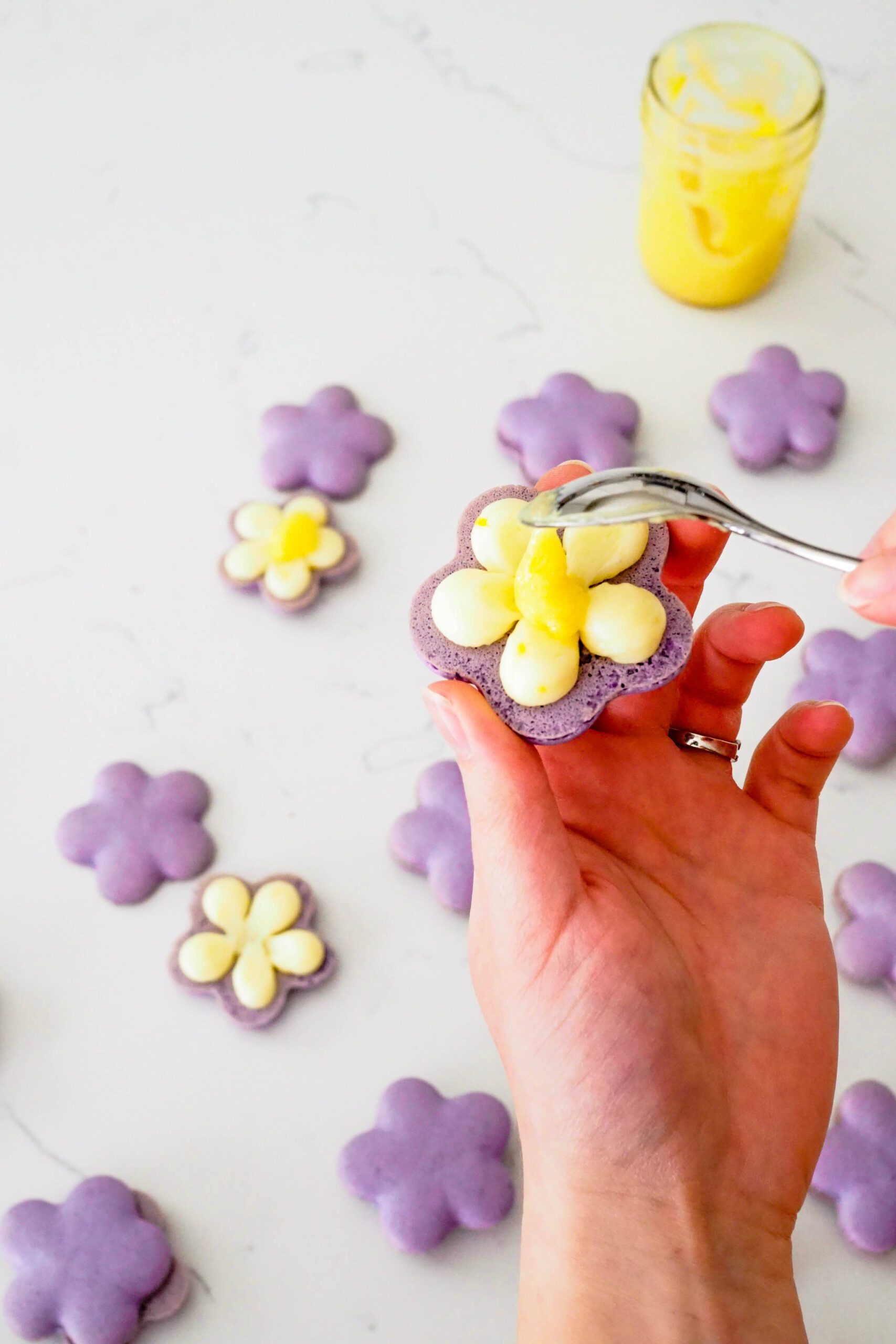Flower-shaped lavender macaron shells are flavored with lavender buds and filled with lemony buttercream and fresh lemon curd—the perfect way to welcome spring! I’ve included a piping template you can place under your parchment paper or silicone mats if you want to make these lemon lavender macarons flower-shaped, though this recipe also works with regular circular macarons.
The lavender macaron shells are made with ground lavender buds in the meringue, and then I use my small-batch lemon curd recipe to flavor the buttercream and fill the center. These lavender macarons pair deliciously with my lavender chocolate chip cookies and iced London fogs for a floral-themed gathering.
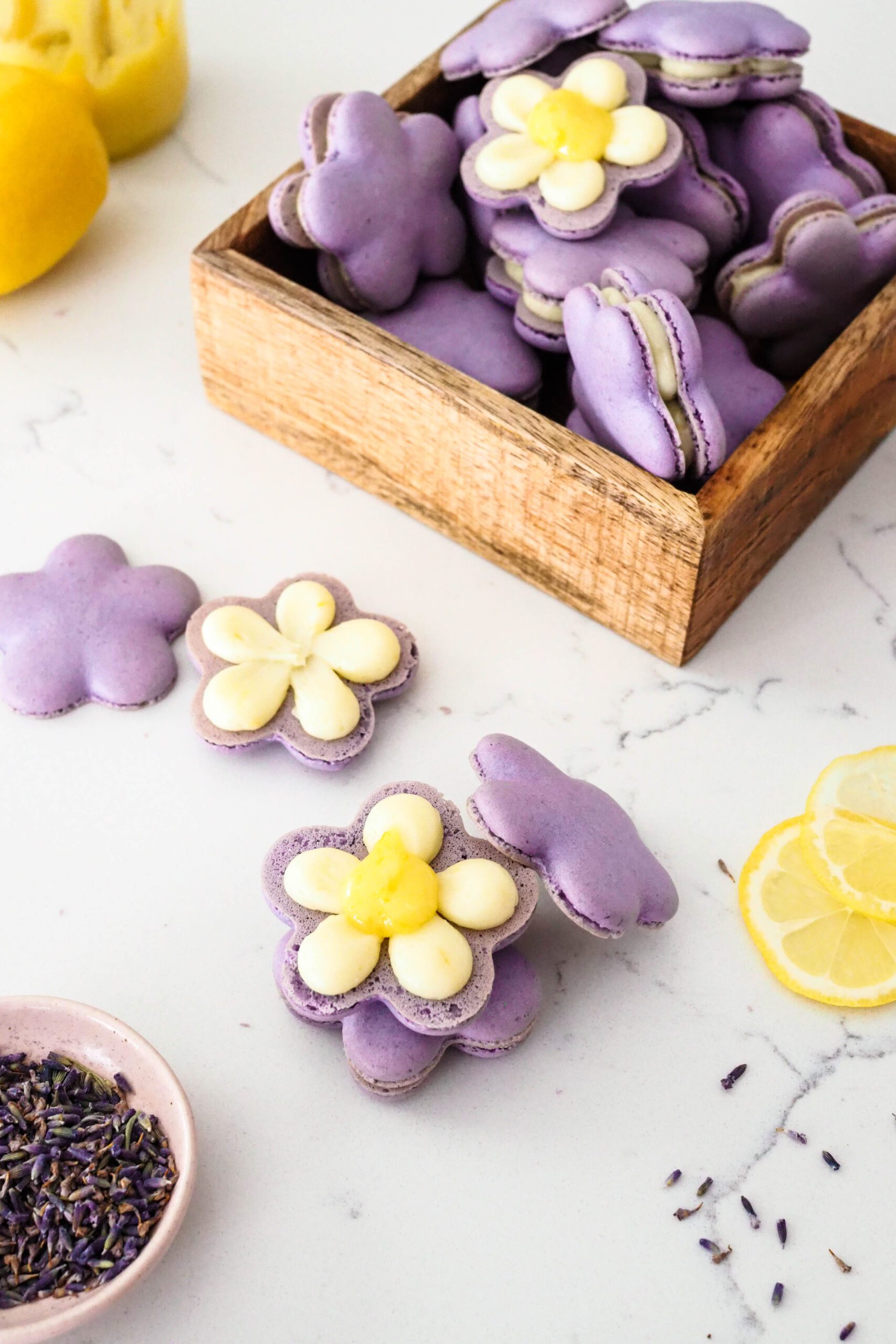
Ingredients for Lemon Lavender Macarons
French macarons require only four ingredients to get right; it’s the fillings that add to the list here! Macarons are made with a simple mix of almond flour, powdered sugar, and meringue, made from egg whites and granulated sugar. The lavender and lemon curd in these macarons adds the wow factor.
- Culinary lavender. Be sure to use culinary-grade lavender. Culinary lavender is grown specifically for the taste, whereas some varieties of lavender are grown for the aromatics and can taste soapy.
- Granulated sugar. Sugar helps to stabilize the meringue, allowing you to fold in the almond flour mixture and rest the macarons without worrying about the meringue collapsing.
- Almond flour. Almond flour provides structure for the macaron shell and a nutty flavor.
- Powdered sugar. Powdered sugar helps to thicken the macaron batter and provide structure.
- Egg whites, from four large eggs. For best results, use fresh eggs rather than egg whites in a carton. Those egg whites are pasteurized and may not whip into a meringue.
- Violet gel food coloring (optional). Please do not use liquid food coloring—it will not work! If you don’t have any gel food coloring, I recommend this kit from Americolor. It has all the colors you’ll need!
- Unsalted butter. Unsalted butter makes up the body of the lemon curd buttercream.
- Lemon curd. This is what gives the lemon lavender macarons their lemony flavor. I like to use my small-batch lemon curd recipe, but you are welcome to use your favorite (homemade or store-bought).
- Powdered sugar. This thickens and sweetens the buttercream.
- Flower macaron piping template (optional). I created this flower macaron template for you to use when making your macarons!

How to Make Lemon Lavender Macarons
The most important thing to remember is that macarons are finicky. Even if they don’t look perfect, they’ll still taste great!
The number one tip I have for making French macaron shells is to be patient. It can take a number of tries to get a perfect batch. It took me quite a few months to feel confident that each batch of macarons I put in the oven would turn out, and then I started my whole macaron-making process over when we moved into a new house and got a new oven.
If you have questions about how your macarons turned out, you can always message me on social media. I’m happy to help you troubleshoot!
Recommended Supplies for Making Macarons
I have all my recommended macaron supplies in one convenient location on my Amazon Storefront!
That said, each oven and home have variables. I can’t guarantee that these supplies will turn out perfect macs for you, though I have had great success with them in multiple ovens.
In my old house and old electric oven, I could use a dark nonstick pan and parchment paper on top of silicon macaron mats with no issues. In my new house and new gas oven, I have to use aluminum pans with silicon macaron mats (affiliate links). Even with my new gas oven, I battle hollow macarons on a regular basis. I recently purchased Breville’s Smart Oven Air Fryer Pro, which is completely electric, and I noticed a difference in the first batch (though it hasn’t gotten rid of the hollow shells completely).
If you are following all the steps and your macarons still aren’t consistent after three batches, I would look into your supplies. Try changing one variable at a time to determine what the problem is.
Macaron Flower Template
Print out this free macaron flower template I created to help you get perfect flower-shaped macarons. Print out one or two of these templates, then place them under parchment paper or silicone mats. Pipe your macarons on top, following the flower guide, then reuse again and again!
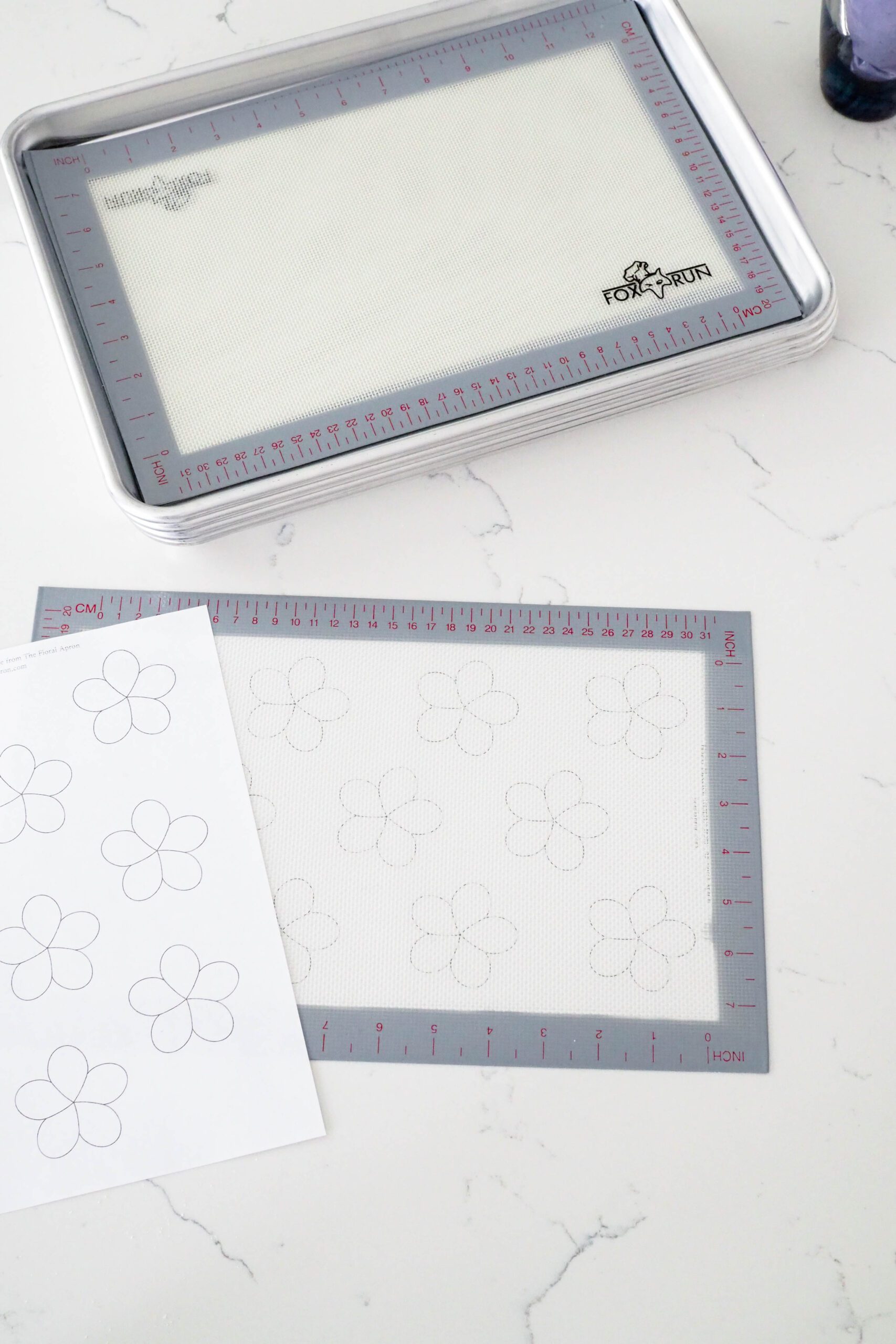
Making the Lavender Sugar
The most important part of the lavender macaron shells is the lavender! I tested this recipe a few different ways and much prefer the texture and flavor of the lavender when it has been ground together with the granulated sugar that’s added to the meringue.
The French meringue still forms perfectly with the ground lavender sugar, and the flavor is much more pronounced. And, my personal favorite: You won’t find full lavender buds hiding somewhere in your mouth an hour after eating these macarons!
To make the lavender sugar, grind the lavender buds and granulated sugar together in a mortar and pestle until the lavender is well-ground and the sugar resembles a coarse powdered sugar.
If you don’t have a mortar and pestle, you are more than welcome to use your food processor. Keep in mind that the lavender isn’t processed quite as well, and you will have larger pieces in your macarons.
The Perfect Lavender Meringue Base
A good meringue is key for a good macaron. French macarons generally call for aged or at least room temperature egg whites—I can use eggs directly from the fridge without a stabilizer because of the way I mix up my meringue.
I adapted this technique from Cenk Sönmezsoy’s The Artful Baker (though he recommends room temperature egg whites). If you’re newer to meringue, I would recommend using room temperature egg whites, as they are a bit more elastic (read: forgiving).
For a perfect French meringue every time, start by whipping the egg whites on low in a stand mixer, just to incorporate. Once the whites begin to foam, increase the speed to medium. The whisk will begin to leave trails in the foam; at that point, sprinkle in the lavender sugar about a teaspoon at a time.
When all the sugar is incorporated, increase the speed to high and whisk until you begin to see the whisk leave deep indents in the meringue (anywhere from three to five minutes). Add the gel food coloring at this point.
Test to see if the lavender meringue has stiff peaks by removing the whisk and flipping it upside down. If the meringue stands straight up or curls into itself lightly with a sharp point, stop whisking. (See photo below.) If the point is soft and looks like it has a lot of tiny bubbles in it, whisk for another 10 seconds, then test again.
The Perfect Macaron Batter Consistency
Macaron batter needs to be a certain consistency in order to develop feet. The consistency and process is so important that it has its own name: “macaronage.”
Macaronage Is a Process
The egg whites start out as liquid with no air in them. Then you whip in lots of very tiny air bubbles to transform the egg whites into a meringue. You have added so much air into the egg whites that now they essentially function as a solid instead of a liquid.
Then, you fold in almond flour and powdered sugar. As you fold the batter with a spatula, you are knocking the air out of the meringue. That helps to transform our meringue back into a liquid batter. The more folds you give the batter, the more liquid the batter becomes. (My husband says this is called viscosity, but that’s a bit technical.)
The perfect consistency of macaron batter will look grainy as it flows off the spatula in one long, stacking ribbon. Then, it will begin to look shiny and absorb back into the rest of the batter within 10-15 seconds.
If your batter takes more than 15 seconds to absorb, you need to knock more air out of the meringue. Too much air in the macarons will make them crack in the oven.
If your batter takes closer to 5 seconds to absorb, it’s likely overmixed; however, it will probably still turn out decent macarons. Unfortunately, if your batter absorbs immediately, there is not enough air left in the meringue to form proper macarons. I recommend starting over.
Do I Really Need to Weigh the Ingredients for Macarons?
YES. If there was ever a case for all-caps, this is it. I typically include both volumetric (cups) and mass (weight) measurements on my recipes, but because macarons are so finicky, I have only included mass measurements. Yes, this requires a kitchen scale, but it is worth it to get perfect macarons every time.
Kitchen scales are relatively inexpensive as far as minor appliances go, and they will last you forever. I have this kitchen scale from OXO and love it.
Piping the Flower-Shaped Macarons
I recommend using the template for flower-shaped macarons if you are a confident macaron baker with a fair amount of piping experience. The batter can be a little tricky to pipe neatly until you know how it flows.
Prepare the template underneath a silicone mat or parchment paper. Make sure it’s straight (or close enough). If you are using half-sheet pans, I recommend printing out two templates and using them side-by-side for ease.
Using a small round piping tip (#8), pipe a circle of batter at the end of a petal until the circle of batter is even with the curve of the petal. Let up on the pressure and drag the piping tip towards the center of the flower. Quickly move onto the next petal, repeating the process until all five petals have been filled.
Once the whole tray has been piped, pick up the pan with one hand and bang the heel of your other hand against it in various locations under the macarons until you see air bubbles rise from the bottoms of the shells. Alternatively, bang the pan against the counter a few times.
Let the macarons rest until they are dull and don’t leave a residue when you lightly run your finger across the top.
Quick Tips for Making Lemon Curd Buttercream
This is the easiest and most delicious lemon buttercream I know of. It’s creamy, not too sweet, and is made from just three ingredients: Lemon curd, powdered sugar, and butter.
Beat the butter by itself to get light and fluffy in the mixer, then add in the powdered sugar and about 3 Tablespoons of lemon curd. Beat until well-combined and fluffy, about three minutes. That’s it!
How to Fill Lemon Lavender Flower Macarons
To get a beautifully filled flower macaron, it’s necessary to pipe the filling in dollops. One large squeeze in the center of the macaron won’t work here, as it won’t spread fully to the edges.
Use a small round piping tip (like #10) to pipe small dollops of buttercream on the edges of the petals, then drag the buttercream towards the center. This ensures the buttercream piping matches the shape of the flower petals and makes a home for the lemon curd.
Use a small spoon or another piping bag to place a small dollop of lemon curd into the center of each macaron before topping it with a similarly-sized macaron shell.
Other Recipes You May Enjoy
If you’re up to making macarons, you’re ready to make anything else on my blog. These all pair nicely with my lemon lavender macarons:
Dish Cleanup: Gonna Take a While
I rate my recipe cleanups on a scale of 1 to 5. 1 is only a handful of dishes, and 5 is everything including the kitchen sink.
My lemon lavender macarons recipe has a cleanup rating of a 4. This is standard for many macaron recipes, as they require one mixing bowl for the batter and one for the buttercream, along with mixer attachments and spatulas. This recipe uses an additional mortar and pestle (if you have one) that helps to break down the lavender better than a food processor can.

Lemon Lavender Macarons Recipe
Lemon Lavender Macarons

Flower-shaped lavender macaron shells are flavored with lavender buds and filled with lemony buttercream and lemon curd for a delectable, bite-sized treat. Piping template included!
Ingredients
For the Lavender Macaron Shells
- 1 Tablespoon culinary-grade lavender (3g)
- 50g granulated sugar
- 120g almond flour
- 200g powdered sugar
- 120g egg whites, from about four large eggs
- 3 drops violet gel food coloring (optional)
For the Lemon Curd Buttercream and Filling
- 7 Tablespoons unsalted butter (100g)
- 1 cup powdered sugar (120g)
- ¼ cup lemon curd, divided (120g)
Instructions
Making the Macarons
- Prepare two baking sheets with macaron silpats or parchment paper, and (optionally) print out my free template for the flower shapes (available in the body of the blog post). Prepare a piping bag fitted with a round tip (I use Wilton or Ateco #8) and set aside.
- In a mortar and pestle, grind the culinary lavender with the granulated sugar. A mortar and pestle works best to really break down the buds, but a food processor will work, too. Transfer the lavender sugar into a small bowl, and set aside.
- For perfectly smooth shells, process the powdered sugar and almond flour together in a food processor for a superfine consistency. Set aside.
- Separate the eggs. Place the egg whites in the bowl of a stand mixer fitted with the whisk attachment and mix on 2 (or low) until frothy. Increase speed to 4 (medium-low). Once the whisk begins leaving a trail in the egg whites, sprinkle in the lavender sugar about a teaspoon at a time. Once all the sugar is incorporated, increase speed to 6 (medium) and whisk until stiff peaks form. The meringue will clump into the base of the whisk and look gray from the lavender.
- Add in the violet gel food coloring, if desired. Whisk on medium for just a couple of seconds to fully incorporate.
- Remove the bowl from the stand mixer and pour half of the almond flour mixture into the meringue. Fold together until fully incorporated, scraping the sides and bottom of the bowl. Add in the remaining almond flour mixture and fold together. The mixture will be thick, but as you continue folding, it will lose some air and thin out. Continue folding and pressing the batter into the sides of the bowl until the batter is the correct consistency (covered in the next step).
- To test the consistency, scoop the batter up, and let it flow back into the bowl. Continue folding until the mixture flows in one solid ribbon off the spatula. It should look a bit grainy as it flows off the spatula, then dissolve back into the batter in 10-15 seconds and look glossy instead of grainy.
- Pour the batter into the prepared piping bag. For flower-shaped macarons, place the template underneath the silpat or parchment paper. Holding the bag at a 90° angle to the pan, gently squeeze out the macaron batter, starting at the circular ends of the petals. Once the batter fills up the end of the petal, let up on the pressure and drag the piping tip towards the center of the flower. Quickly move onto the next petal, and repeat until all petals have been covered. Alternatively, you can pipe regular, circular macarons.
- Once piped, pick up the pan with one hand and bang the heel of your other hand against it in various locations under the macarons until you see air bubbles rise from the bottoms of the shells. Alternatively, bang the pan against the counter a few times. Use a toothpick to pop any remaining bubbles for a perfectly smooth top. Notice how shiny the surface looks now; it will dull as the macarons rest.
- Set the macarons aside in a well-ventilated area to dry for about 20-30 minutes. On particularly humid days, this may take up to an hour.
- While the macarons are drying, preheat the oven to 320°F/160°C. The macarons are ready to go in the oven when the tops are no longer reflective, don't leave a residue on your finger when touched, and feel like skin when you lightly run your finger across it.
Baking the Macarons
- Once the macarons are dry, bake one tray at a time in the center rack for about 10 minutes or until the macaron is set. These macarons bake faster and brown more quickly because of the difference in shape. Regular macarons will take closer to 15 minutes to fully bake.
- Test to see if the macarons are set: Try to gently wiggle a macaron back and forth from the center of the pan with your thumb and forefinger. If the top moves at all, put the tray back in the oven for another minute or two until the center of the macaron is set and does not move when prompted.
- Let each tray cool completely before removing the macarons from the mats, about 10 minutes.
Making the Lemon Buttercream
- Cream the butter in a medium bowl or the bowl of a stand mixer.
- Add in the powdered sugar and only 2-3 Tablespoons of lemon curd. Beat for three minutes to fully combine until the buttercream is light and fluffy. Transfer to a piping bag fitted with the piping tip of your choice.
Assembling the Macarons
- Pair similarly sized macarons together and line them up with one side face up and one side face down.
- On a flower macaron shell with the flat bottom facing up, pipe small dollops of lemon curd buttercream at the ends of each petal. Fill the center with a small dollop of the remaining lemon curd. Repeat with the rest of the macarons, then place the matching macaron shell on top.
- The macaron shells will soften and the flavors will develop (especially the lavender) after maturing in the fridge for one day, though you may eat them any time you'd prefer after assembly.
Notes
Store in the fridge in an airtight container for up to a week for maximum freshness.
Recommended Products
As an Amazon Associate and member of other affiliate programs, I earn from qualifying purchases.
Nutrition Information:
Yield:
30Serving Size:
1Amount Per Serving: Calories: 112Total Fat: 6gSaturated Fat: 2gTrans Fat: 0gUnsaturated Fat: 3gCholesterol: 35mgSodium: 21mgCarbohydrates: 14gFiber: 1gSugar: 13gProtein: 2g
The nutrition facts are estimated and may vary based on specific ingredients used.
Thanks for trying out my lemon lavender macarons recipe! Please consider rating this recipe so others find it, too.
I’d love to see how your recipe turns out: Take a photo and tag me on Instagram @floralapronblog to share with me, or use the hashtag #floralapronbakes.
This post contains affiliate links. If you click through and make a purchase, I may receive a small commission at no cost to you. Thank you for helping to support The Floral Apron!

